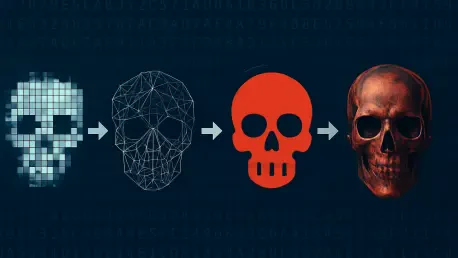In a digital landscape where cyber threats loom larger than ever, Chaos ransomware has emerged as a formidable adversary, transforming from a standard file-locking menace into a sophisticated, multi-dimensional threat known as Chaos-C++. This C++-based variant represents a seismic shift in the ransomware arena, moving far beyond traditional extortion tactics to incorporate data destruction, system sabotage, and persistent financial exploitation. No longer content with merely encrypting files for ransom, this evolved strain deploys a complex arsenal designed to maximize both immediate damage and long-term revenue for attackers. Its ability to disable recovery mechanisms and linger in systems for ongoing theft marks a troubling escalation in cybercrime. As businesses and individuals grapple with this heightened risk, understanding the depth of this transformation becomes paramount. The implications of such an advanced threat ripple across industries, demanding urgent attention to how defenses must adapt to counter an enemy that thrives on chaos and innovation.
Technical Advancements of Chaos-C++
Tiered Encryption and Destructive Tactics
Chaos-C++ has redefined ransomware lethality through a calculated, tiered encryption strategy that prioritizes both efficiency and devastation based on file size. For smaller files under 50MB, it employs robust AES-256-CFB encryption via Windows CryptoAPI functions, ensuring that critical documents are locked tight with little hope of recovery without payment. This targeted approach focuses on high-value data that organizations rely on daily, amplifying the urgency to comply with demands. Meanwhile, medium-sized files between 50MB and 1.3GB are strategically skipped, likely to maintain operational speed and evade detection by minimizing processing overhead. This selective encryption reflects a chilling pragmatism in design, balancing impact with stealth. The result is a ransomware variant that doesn’t just hold data hostage but manipulates the very rhythm of an attack to stay under the radar, making it harder for traditional security measures to intercept before significant harm is done.
For larger files exceeding 1.3GB, such as databases and backups, Chaos-C++ takes an even darker turn by outright deleting content rather than encrypting it. This destructive tactic obliterates any chance of recovery, even if victims meet the ransom demands, marking a stark departure from the conventional ransomware model where decryption keys are dangled as a carrot. The intent here is clear: to inflict permanent damage that cripples operations and forces compliance through sheer desperation. Additionally, the malware incorporates an XOR-based fallback encryption for environments where standard cryptographic libraries are inaccessible, showcasing its adaptability to diverse systems. This blend of selective encryption and outright destruction underscores a shift in attacker priorities, where causing irreversible harm often outweighs the potential for reversible extortion. Such an approach challenges the very foundation of ransomware defense, as it negates the possibility of negotiation or restoration in many cases.
Evasion and Deployment Sophistication
One of the most insidious aspects of Chaos-C++ lies in its ability to disguise itself as legitimate software, specifically under the guise of “System Optimizer v2.1.” By presenting convincing optimization messages, it lulls unsuspecting users into a false sense of security while silently executing its malicious payload in the background. This social engineering tactic is paired with advanced persistence mechanisms like mutex creation to ensure the ransomware maintains control over infected systems. Furthermore, it manipulates console window titles to mimic legitimate processes such as svchost.exe, blending seamlessly into routine system operations. These deceptive strategies highlight a deep understanding of user behavior and system architecture, allowing the malware to operate undetected during its critical initial stages. The sophistication of this deployment method poses a significant challenge to conventional antivirus solutions that rely on signature-based detection.
Beyond its deceptive facade, Chaos-C++ employs strategic delays in its execution to evade automated sandbox analysis, a common tool used by cybersecurity professionals to identify threats. By delaying malicious actions, it avoids triggering immediate alerts in controlled environments, increasing the likelihood of successful infiltration in real-world scenarios. Additionally, the ransomware checks for administrative privileges before unleashing system-destructive commands that target recovery mechanisms like Volume Shadow Copy services and Windows backup catalogs. Disabling these critical components ensures victims have no fallback options, intensifying the pressure to pay the ransom. This combination of stealth and sabotage illustrates a level of technical prowess that sets Chaos-C++ apart from its predecessors, demanding a rethinking of how threats are detected and mitigated in an era where attackers exploit both technology and human trust with alarming precision.
Financial Exploitation Beyond Ransom
Cryptocurrency Theft via Clipboard Hijacking
A particularly alarming innovation in Chaos-C++ is its integration of cryptocurrency theft through clipboard hijacking, a tactic that extends its impact far beyond the initial infection. After completing its encryption or destruction phase, the malware shifts into a surveillance mode, continuously monitoring clipboard activity for Bitcoin wallet addresses. Using pattern recognition to detect formats like P2PKH, P2SH, and Bec###2, it silently replaces legitimate addresses with those controlled by attackers. This redirection ensures that any cryptocurrency transactions—whether tied to the ransom or unrelated personal transfers—are intercepted, diverting funds to malicious hands. Operating discreetly via Windows Clipboard API functions, this mechanism can persist long after the initial attack, transforming the ransomware into an ongoing financial threat that undermines trust in digital transactions.
The lack of precise validation in this clipboard hijacking means that any string resembling a wallet format may trigger replacement, heightening the risk of collateral damage to legitimate activities. Victims might not even realize their transactions are being rerouted until significant losses have occurred, as the malware operates in the background without overt signs of interference. This persistent financial exploitation redefines the scope of ransomware, moving it from a one-time extortion event to a prolonged drain on resources. It also highlights the growing intersection between ransomware and other forms of cybercrime, where financial theft becomes a parallel objective. As digital currencies gain prominence, such tactics are likely to proliferate, necessitating heightened vigilance and specialized tools to detect and block unauthorized clipboard access before irreparable harm is done.
Dual-Revenue Model
Unlike traditional ransomware that relies solely on one-time payments for decryption keys, Chaos-C++ maximizes profit through a dual-revenue model that combines ransom demands with sustained cryptocurrency theft. After encrypting or deleting files, it drops a ransom note in the %AppData% directory, complete with payment instructions, contact details, and a unique victim identifier to facilitate extortion. This conventional approach ensures attackers can capitalize on the immediate desperation of victims seeking to recover critical data. However, the addition of clipboard hijacking as a secondary revenue stream marks a significant evolution, allowing attackers to extract value from compromised systems over an extended period. This dual strategy reflects a broader trend in cybercrime toward multi-vector attacks that exploit multiple vulnerabilities for continuous gain.
The implications of this dual-revenue model are profound, as it transforms ransomware into a long-term parasite within infected systems. Even if victims pay the initial ransom or mitigate the encryption damage, the ongoing theft of cryptocurrency transactions can result in substantial financial losses over time. This persistence challenges the traditional incident response framework, which often focuses on containment and recovery following the primary attack. Instead, organizations must now account for secondary threats that linger undetected, siphoning resources long after the initial crisis appears resolved. The sophistication of this approach underscores the need for comprehensive security measures that address not only the immediate impact of ransomware but also the hidden mechanisms designed to exploit victims indefinitely, pushing the boundaries of what constitutes a cyber threat in the modern age.
Implications for Cybersecurity
Shifting Threat Landscape
The emergence of Chaos-C++ signals a dramatic shift in the ransomware landscape, where threats are no longer confined to temporary disruptions but evolve into persistent, multi-dimensional assaults. Its destructive tactics, such as deleting large files without offering recovery options, challenge the conventional response model of negotiating with attackers or restoring from backups. The malware’s ability to disable critical recovery mechanisms like boot configuration settings ensures that victims are left with few alternatives, amplifying the coercion to pay. Moreover, its stealth capabilities and ongoing financial exploitation through cryptocurrency theft reveal the limitations of security tools designed solely to block initial infections. This new breed of ransomware demands a broader perspective on threat management, where the focus extends beyond prevention to mitigating long-term risks that persist post-infection.
This shifting landscape also highlights the inadequacy of traditional cybersecurity frameworks against adversaries that prioritize permanent damage and sustained exploitation. Behavioral analysis and continuous monitoring become essential to detect subtle indicators of ongoing activity, such as clipboard manipulation, that standard antivirus solutions might overlook. The destructive nature of Chaos-C++ means that even successful ransom payments may not restore operations, as critical data is often irretrievable. As attackers refine their strategies to inflict maximum harm, the psychological and operational toll on victims intensifies, necessitating a fundamental reevaluation of how cyber threats are prioritized and addressed. Organizations must adapt to a reality where ransomware is not a singular event but a prolonged battle against an enemy designed to exploit every vulnerability over time.
Need for Enhanced Defenses
To combat the sophisticated threat posed by Chaos-C++, organizations must prioritize prevention through robust endpoint protection and regular system updates to close exploitable vulnerabilities. User awareness training is equally critical, as social engineering tactics like the “System Optimizer v2.1” disguise rely on human error to gain initial access. Educating staff to recognize suspicious software and phishing attempts can significantly reduce the risk of infection. Additionally, maintaining air-gapped, offsite backups provides a lifeline against destructive ransomware tactics that target local recovery options. These proactive measures form the first line of defense, aiming to stop threats before they can execute their devastating payloads. However, given the stealth and persistence of this malware, prevention alone is not enough to address the full spectrum of risks it introduces.
Post-infection strategies are just as vital, requiring advanced monitoring to detect secondary activities like clipboard hijacking that can drain financial resources long after the initial attack. Tools designed to identify unauthorized clipboard access or anomalous transaction patterns can help mitigate ongoing cryptocurrency theft. Incident response plans must also evolve to account for irreversible data loss, emphasizing rapid containment and the restoration of operations from secure backups. Furthermore, the integration of financial exploitation into ransomware campaigns calls for heightened vigilance around digital transactions, potentially incorporating blockchain analysis to trace and block illicit transfers. By adopting a multi-layered defense strategy that spans prevention, detection, and recovery, organizations can better position themselves to withstand the immediate and prolonged impacts of advanced threats like Chaos-C++, ensuring resilience in an increasingly hostile digital environment.
Adapting to a New Era of Cybercrime
Looking back, the transformation of Chaos ransomware into Chaos-C++ stood as a defining moment in the battle against cyber threats. Its blend of tiered encryption, destructive file handling, stealthy evasion tactics, and persistent financial exploitation through cryptocurrency theft redefined the scope of ransomware, turning it into a comprehensive assault on both data and finances. This detailed exploration illuminated the malware’s innovative strategies and the alarming trends they represented, painting a clear picture of a threat that demanded urgent and adaptive responses. The lessons learned underscored the inadequacy of reactive measures alone, as attackers shifted toward inflicting permanent damage and sustained harm. Moving forward, the path to security lies in embracing proactive defenses—strengthening endpoint protection, fostering user awareness, and investing in continuous monitoring to catch lingering threats. By prioritizing secure, offsite backups and specialized tools to safeguard digital transactions, organizations can build resilience against the evolving dangers of cybercrime, ensuring they stay one step ahead in a relentless digital arms race.









